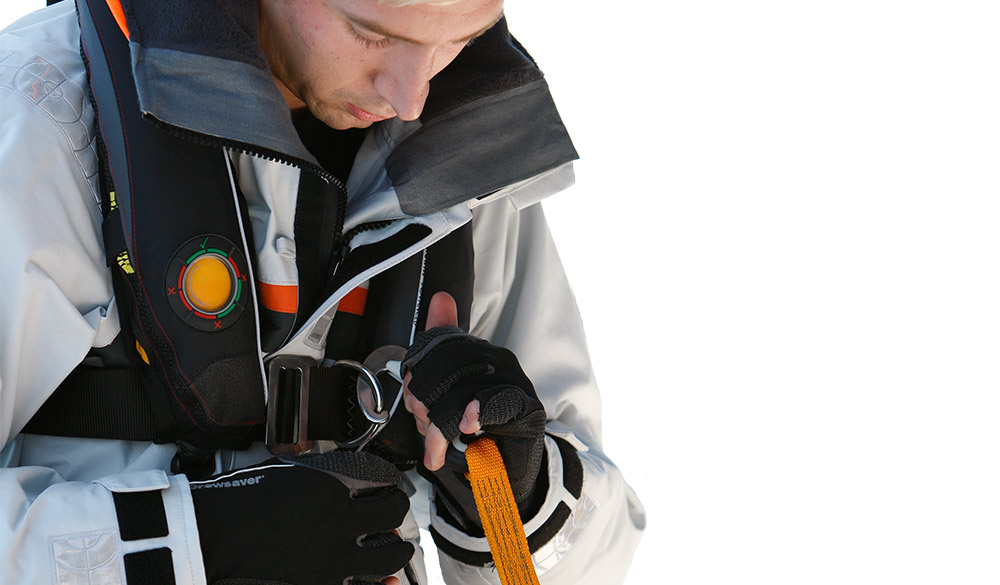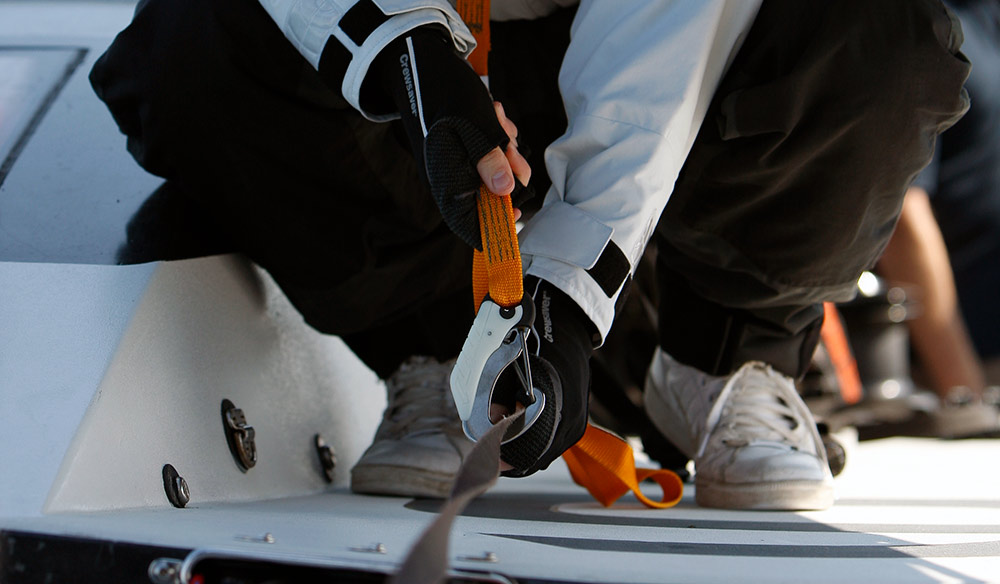Safety Lines: Clipping on
Safety lines, also known as lanyards, or tethers are an essential addition to your onboard safety equipment
What is a safety line?
A safety line is a piece of equipment that clips your safety harness to a strong attachment point on your boat. The primary aim of wearing a safety harness and a safety line is to prevent you from falling into the water and to assist in recovery to deck if you do.
Preventing a safety line wearer from falling into the water is dependent on the location of their attachment to the boat and the safety lines length. Use of a safety line ensures that if a person falls overboard, they remain connected to their vessel and can be pulled back onboard. Clipping on with a safety line is particularly important for individuals who are working on deck, at night, or in rough weather where they might face higher risks of falling overboard.
Safety lines should always be used in conjunction with a correctly fitted safety harness, which are now commonly built into life jackets, providing additional buoyancy and support in the water. Those using a safety line should know how to use it and where to clip on. It is equally important for the crew to practice how to pick up someone who has gone overboard.
Safety line requirements
The safety line and the harness it's attached to should comply with ISO 12401. However, you may still see EN 1095, which has been superseded by ISO 12401. Where a life jacket is integrated with a safety harness, the safety harness should be certified to ISO 12401 and the life jacket should be certified to ISO 12402. These ISO standards specify the performance, testing and the design and safety requirements.

Safety line length and mobility
The effective function of a safety line depends on its length and where it is attached or clipped onto your vessel. A safety lines optimum length varies from user to boat. Its length is usually based on the size of the boat and the location of the clipping on points and jackstays. Safety lines that comply with the ISO Standard must be no more that 2m in length, but something shorter may be required at times.
Mobility must be balanced against the risk of falling overboard. The safety line needs to be long enough to enable movement around the boat. However, if a long safety line allows a person to fall overboard into the water, a shorter safety line should be used when working in an exposed position. For example, on the foredeck where the distance to the guard lines is much reduced. On a heeled boat always clip on the windward side so if you do fall, you fall across the boat.
A common solution to the need for safety lines of longer and shorter lengths is a mid-point hook. This allows the user to change the clipping on point without being detached from the boat, meaning the user has a shorter safety line to hand when one is needed.
Attachment points
Safety lines can only work effectively if there are adequate attachment points on a boat. Guardrails are not built to take the loads imposed by a safety harness and should not be used as attachment points.
Attachment points adjacent to the exit from the accommodation space are recommended to clip onto, as are clipping on points adjacent to exposed steering positions. A jackstay running the length of a boat is useful to facilitate clipping on when working on exposed side decks. Further strategically placed clipping on points may also be beneficial for example at the mast for reefing. It is vital that your attachment points and jackstays are well maintained.
Jackstays should be placed as close to the centre of the boat as possible. This helps reduce the risk of someone falling overboard, by keeping them attached to the boat. This is particularly important if your boat has a low freeboard, as you can still drown even falling overboard and attached to the boat.
Anyone who falls overboard from a motor cruiser at speed potentially risks serious injury. Because of this, it’s important to have harness attachment points close to the centre of the deck to prevent this. It’s vital for attachment points to be positioned in a way that prevent casualties, such as being dragged into the propeller.

MAIB safety bulletin
In January 2018, the Marine Accident Investigation Branch (MAIB) issued a safety bulletin to highlight an urgent safety lesson following a fatal man overboard incident.
MAIB Safety Bulletin 1/2018 contains important guidance on the use of safety lines, developed from the incident.
Purchasing
Safety lines can be purchased either online or from most good chandleries. 2 and 3 hook safety lines are available from most manufacturers. Some manufacturers supply elasticated versions and have an overload indicator to help you to decide when the safety line needs replacing.
Shorter safety lines that are suitable for your boat may not be readily available and may have to be sourced from a reputable sailmaker. Always remember to check your safety lines regularly for wear.
The hooks on a safety line are designed so they cannot be accidentally opened. An ISO 12401 approved safety line is fitted with hooks which have been designed and tested to prevent this.
For further information on staying safe onboard, visit the RYA safety hub.
